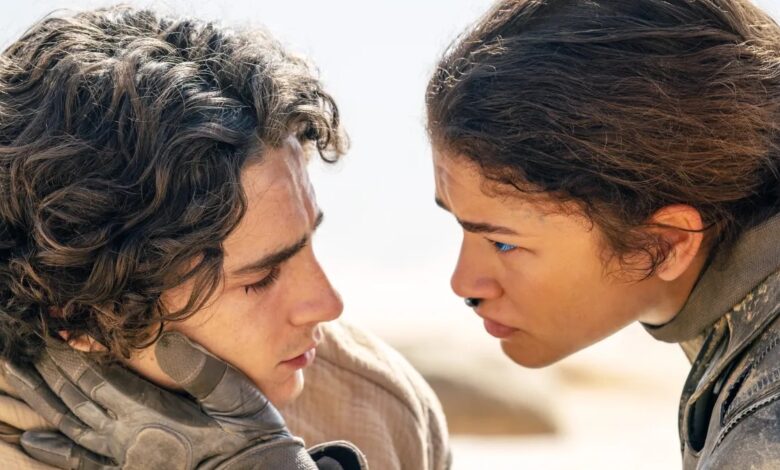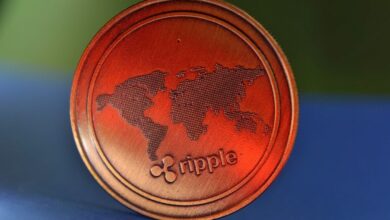Dune: Part 2 tries to balance the book’s canon with creative license (spoilers)

When I watched the start of the Denis Villaneuve’s first Dune movie (2021) with my youngest kid, it was a special moment that took me back decades.
I’ve been a superfan of the Dune universe ever since I read the books decades ago and the first film prompted me to re-read the first trilogy. And as I watched Dune: Part 2 this week at a special Warner Bros. screening, I know I should have been overjoyed to see that the curse of bad Dune adaptations was lifted. But I had to suppress feelings of becoming a supercritic. I think you should see both movies, but as a sci-fi devotee, I have to wonder whether the films — which are so well done — really do justice to the Frank Herbert novel that first debuted in 1965. (To explain some of this, this review is full of spoilers).
In the first film, the Gom Jabbar test was an important scene. Young Paul Atreides (Timothée Chalomet) will one day be the Duke leading a Great House of the galaxy. But the Bene Gesserit (a group of women who manipulate and pull strings to control the galaxy) need to test whether he is really human.
The reverend mother makes Paul put his hand into a black box. He feels pain and wants to pull it out. Then she pulls out a poisoned needle (the Gom Jabbar) and holds it to his neck. If he pulls his hand from the box, she says she will kill him with the needle. It tests whether his animal instincts — triggered by the pain in the box — will override his human awareness of the needle.
GB Event
GamesBeat Summit Call for Speakers
We’re thrilled to open our call for speakers to our flagship event, GamesBeat Summit 2024 hosted in Los Angeles, where we will explore the theme of “Resilience and Adaption”.
Litany against fear

Paul’s mother Jessica, a Bene Gesserit herself, has to endure this test waiting outside the room. Her recitation of the “Litany Against Fear” is one of the most moving passages in the book and in the movie as well. When I was young, this litany helped me master my fears. I passed it on to all of my kids in what I considered good parenting.
The film scene was so well done that it washed away any concern I had about the film being faithful to the book. It swept away the images in my head from the original David Lynch Dune film (1984), which were hard to shake. That film had Sting, but it tried to cram too much into two hours and 17 minutes. The actors in this film — Chalomet, Zendaya, Rebecca Ferguson among them — are very well cast.
Passages such as the Litany Against Fear — told in terse ways where you can get inside the mind of a character — were what made the original book and the first movie into masterpieces of science fiction. It is what compelled me to ready all six of Frank Herbert’s books, and devour another six written by his son Brian Herbert and Kevin J. Anderson. I cannot believe that there are now another 16 books I still have to read, as the Dune universe has proven to be one of the biggest in all of sci-fi.
Can Dune 2 live up to the first Dune?

There’s no disputing that director Denis Villaneuve’s first movie was amazing and the second one also has flashes of brilliance in turning the words into film. The vision of Fremen riding giant sandworms in the Arrakis desert are so incredibly well done — and visualized in a way that was unexpected for me. It’s such a big moment to learn that these giant monsters can be marshaled for human purposes.
That’s a big plus in the second film, but there are a lot of pacing issues. In the novel, the first part of the book is dedicated to learning about Dune, palace intrigue, and the riveting fall of House Atreides. As Paul and Jessica escape into the desert, the pace slows down.
We learn more about the characters and Paul’s resistance to the solution at hand. He can defeat the Harkonnens by embracing the Bene Gesserit generations-long manipulations of the Fremen to believe in a messiah. But if he becomes that messiah, the galaxy will be subject to a horrifying jihad that will kill billions. This is a story about a reluctant messiah, and while it is not full of action, it is critical to the tale.
As Paul and Jessica go through their transitions, there are drug-filled sequences (it was written in the 1960s, after all) that make for a series of very weird film moments that might be hard for neophytes to grasp. But the film handles them well. You just have to accept the transition to the slower pace. It’s not just a war movie, and it translates scenes that aren’t very film-like into the screen.
The cruelty of the Harkonnens

The film does a good job depicting the cruelty and sexual violence of the Harkonnens, the evil great house that does the dirty work of the emperor. Once they retake the planet and try to crush all resistance, their evil knows no bounds.
As Feyd Rautha, the nephew of the Baron Vladimir Harkonnen, Austin Butler can’t really live up to the star power of Sting from the David Lynch film. But Butler is pretty creepy and the depiction of the gray and Orwellian Harkonnen world is a stark contrast to the freedom and nobility of the Atreides.
To appreciate the goodness of House Atreides and the well-meaning zeal of the Fremen, we have to see what the evil is like. But I do wish we had a missing character — Count Fenring, the emperor’s man and husband of the manipulative Bene Gesserit Lady Margot Fenring (Léa Seydoux) — that captured how the Bene Gesserit and House Corrino conspired to manipulate the Harkonnens. I don’t know why Villaneuve used free reign to edit these minor characters — including Thufir Hawat — into such small or non-existent roles. I mean, he knows the super fans would spot these splinterings of the canon.
The Baron himself (Stellan Skarsgård) is a pretty evil version of the villain, but it’s a bit of a downer that Herbert’s solution for the baron’s demise isn’t in the ending.
Dazzling special effects
These days, computer-generated special effects are always amazing. But across both movies, the special effects bring Dune to life. The haze of the sky over the desert is great, though the city of Arrakeen looks a bit like a toy model sometimes for all of its sameness.
The sandworms are a sight to behold. The book itself has this slight flaw where the Fremen ride sandworms through the area of an atomic blast without getting any radiation sickness. (I love the googly-eyed images of sandworms bearing down on hapless Sardaukar and Harkonnen forces).
The ornithopters are amazing, flying like dragonflies. And the shimmering shields — where shields block fast blows but cannot stop slow parries — are a nice touch. Lasers are quite freely used in the desert. The films include the scene where we see the consequence of using lasers against shields, triggering a subatomic explosion.
I think the Guild spaceships were a bit too big, but they were intimidating. And the action scenes were very realistic, seemingly lifted out of a desert war reel. The stillsuits were also well done, though of course the actors weren’t covered with face masks all the time. These minor differences between the book and the film are forgivable in the visual medium.
What else is missing?

What’s missing from the film is also a little annoying to Dune nerds. The Spacing Guild — one of the major factions which has a monopoly on space travel, enabled by Guild navigators who depend on the spice to “fold space” and avoid running into stars — is entirely missing.
Instead, Villaneuve creates a bogus reason for why the Harkonnens fail to discover the vastness of the Fremen forces in the planet’s Southern Hemisphere. The film suggests that storms stop the Harkonnen aircraft from spotting the Fremen. Instead, in the book, the Fremen bribe the Guild, sending them spice via the smugglers to keep satellites out of the skies of Arrakis. One of the best things about last year’s Dune: Spice Wars game was that it captured the political intrigue among the factions.
Sure, it takes time to introduce these new factions and the characters within them in a film that is going over its time budget. But I could have done with shorter drug-filled scenes. Jessica’s daughter Alia makes her presence known as she rapidly matures into adulthood inside her mother’s womb. But the child-like Alia is nowhere to be found in the ending where she plays a critical part in the book.
It’s in the ending where Villaneuve takes the most creative license to change the canon. Perhaps the most touching part has to do with Paul’s loyalty to Chani even as he needs to arrange a marriage with the emperor’s daughter to restore the peace. Jessica has a great line to Chani, closing the book and repairing some of the rift between Paul and Chani.
But the final scenes are changed, setting up some additional conflict that presumably Villaneuve will use to set up Dune 3. The gravitas of this change to the novel’s ending is so big that it seems like the director will make more changes to the canon as the story picks up with the second novel, Dune Messiah.
Perhaps the ending of Dune 2 was changed to get rid of some of the sexist elements of the original ending. I don’t know about that. But it was jarring to not see some of the material that has stayed in my mind through multiple readings. The previously mentioned absence of Count Fenring, a politician with divided loyalty, also felt like a void in the movie’s close.
Now the films are pretty long. Dune was two hours and 17 minutes, and Dune 2 runs two hours and 46 minutes. Given that, I realize that Villaneuve had to cut things out of the book. The ending is so brilliant that I thought he had to include it in the end of Dune 2. But the story has its challenges.
For sure, we’ll have to wait to see how good Dune 3 is to be sure. I am proud to see that something I treasured so much as a nerdy geek has gotten the big-budget film treatment and risen to the scale of mass culture ($433 million at the global box office).
But when I read Dune in junior high, I was greatly disappointed in Dune Messiah and the third book, Children of Dune, because of the lack of action compared to the first book. Yet when I re-read the books recently, I understood how those books were so much more about characters.
Perhaps the right way to handle this would have been through a streaming TV series, with many more episodes that could capture all the nuances without cutting things out.
Why the Dune universe is so expansive

I haven’t decided whether I’m really annoyed at these canon breaks or not. And it leads me to the question. In this age of (short) video, is it worth reading the books if you’ve seen the movies? Is it worth watching just the TikTok version of the movies?
Of course you should read the books. With 29 books and counting, and an original book with its own glossary, Frank Herbert and his son Brian and Kevin J. Anderson were world builders. It is a rich transmedia universe, with one piece of art inspiring another in a different medium.
Herbert’s imagination captured so many themes. Set in a desert world, you could see the politics of oil, jihad, and the Middle East overlaid on a science fiction universe. The film leans into the characters that seem pulled from Middle Eastern societies. Spice is a valuable resource, just like oil.
Herbert drew inspiration from the Oregon Dunes near where he lived, and he understood the ecosystems of deserts and their harsh conditions. He was ahead of his time in studying climate change and believing in the environmental religion.
He mixed together different religious and philosophical ideas (like fusing Zen and Islam), with cult-like groups like the Bene Gesserit, who believed in genetic manipulation, and the Mentats, who believed AI was such a threat to human existence that turning people into computer-like calculators was the only solution. The figure of Paul and the Kwisatz Haderach drew from the messiahs of our own world.
There are so many political and power dynamics that reflect the relationships of super powers in our own world. The tech planet of Ix reminds me of the fears around the Japanese domination of the tech industry. Writing about these factions gave plenty of fodder for Brian Herbert and Kevin J. Anderson to carry on the story.
I recently wrote about the large language model (LLM) being launched for The Wheel of Time, which has 14 books with four million words and an Amazon TV show. The generative AI-based LLM will be like a canon encyclopedia for fans of The Wheel of Time. And it will instantly remind writers when they are overstepping the canon as they (or fans) write ancillary stories in The Wheel of Time universe. I feel like the Dune writers room should have had access to this kind of AI as they considered their canon-breaking script. But I’m sure these were deliberate choices.
Dune itself would benefit from having a dedicated LLM with nothing but Dune material in the AI model. And I believe that we deserve a Dune video game and a Dune streaming series with multiple seasons in addition to Villaneuve’s work. (Embracer Group’s Funcom has a Dune: Awakening game coming).
Just like the Tolkien universe or the Marvel Cinematic Universe, it’s vast and it can contain multitudes. In that sense, I can tolerate the variants of the story in Villaneuve’s film. But I would encourage you to dive into other interpretations of Frank Herbert’s imagination.
VentureBeat’s mission is to be a digital town square for technical decision-makers to gain knowledge about transformative enterprise technology and transact. Discover our Briefings.


